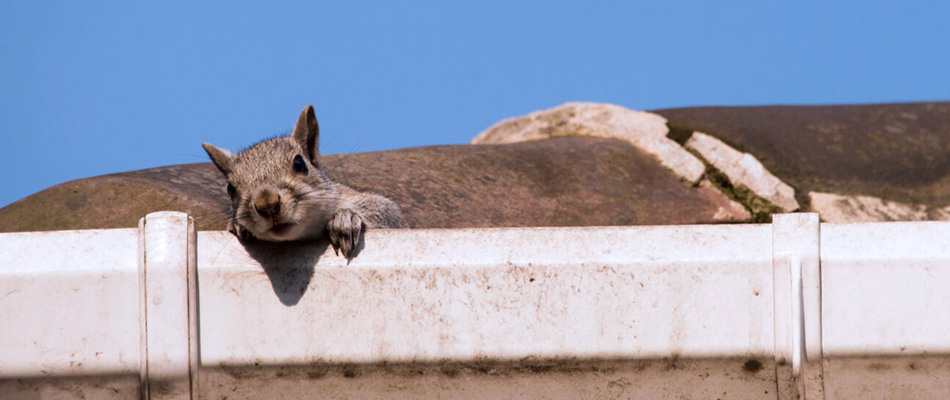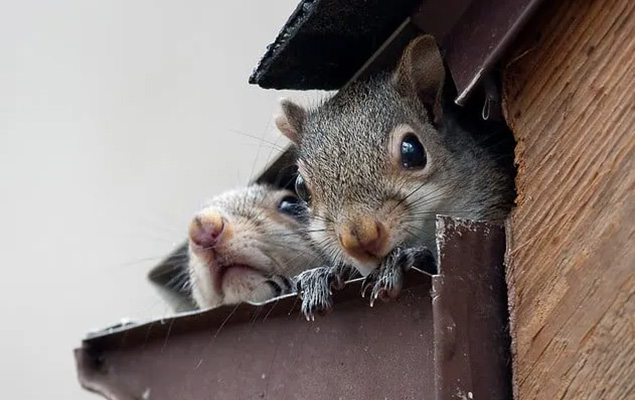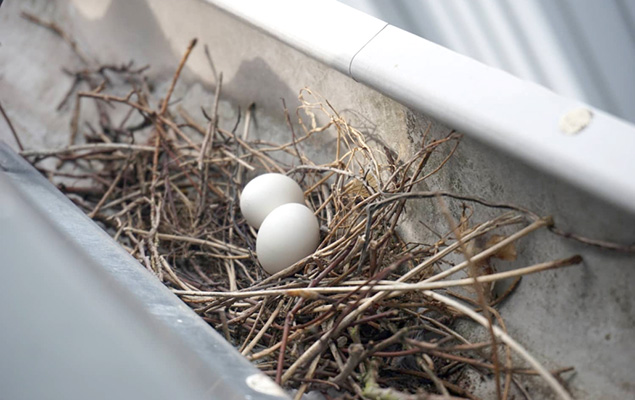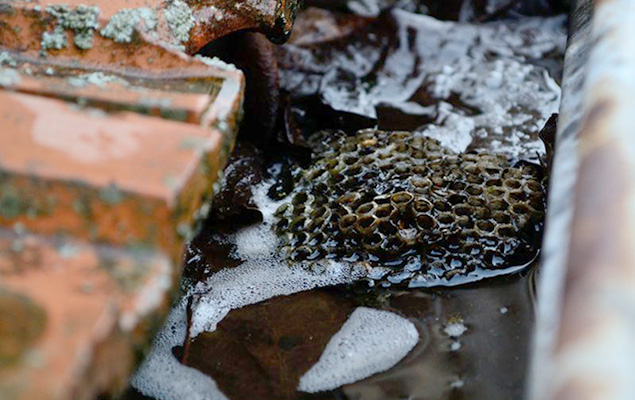Wildlife Remediation Repair
Aged soffits, eaves, and fascias on your home are like an “Open 24/7” sign for squirrels, raccoons, and other creatures. It’s easy to let gutter maintenance fall by the wayside. After all, how many problems can leaves or twigs in your gutters really cause? The debris itself may not lead to extensive gutter damage, though you may deal with buildup that causes clogs or heavy standing water. However, it can make some animals believe your gutters are the ideal place to make a home.
The best solution for keeping critters out of your gutters is often to perform regular maintenance. Critters often make their way into gutters overflowing with leaves or debris that cause standing water or provide materials needed for nesting. Many times wildlife will enter through the gutter system due to the gutters being clogged which causes water to rot the fascia behind them. Rotted fascia makes it easy for squirrels to penetrate and create a hole into the soffit and ultimately gain access to the attic. Keeping gutters clean helps prevent invasive wildlife.
Animals can create havoc on a home or business structure, especially if it goes unnoticed for a lengthy amount of time. While it’s not an animal’s intent to cause damage to your property, the destruction in their wake can be both costly and detrimental to your home’s integrity. If you have one of these critters living in your gutters, soffits, or fascia, there are different approaches to remedy that problem. Many approaches will call for intervention from a pest control and removal expert:
- Mosquitos: Mosquitos thrive in standing water, primarily during the warm spring and summer months. If your gutters have drainage issues, you may have unintentionally created a prime breeding ground.
- Birds: Getting rid of birds in your gutters will depend on whether they have an active nest you’ll need to transport to a new location. While birds aren’t nearly as dangerous or destructive as other pests, their droppings can stain your home’s exterior and clog your gutters. Plus, even when you get rid of a bird’s nest, another may take its place.
- Rodents: Like birds, rodents rely on the debris in gutters to craft their nests. However, squirrels, chipmunks, and mice present more of a hazard than birds because they have a way of finding their way indoors, especially during the colder months.
- Bees and Wasps: Bees and wasps may choose gutters to create their nests because gutters are high off of the ground and relatively safe. While stings are an obvious risk of these nests, another potential issue is the weight of their hives, which could pull down gutters or even compromise your roof.
- Snakes: Snakes are one of the most potentially dangerous pests you can encounter living in your gutters. They may crawl up your gutter’s downspout or into your gutter from a nearby tree. Snakes find everything they need to live in a clogged gutter, including a wet environment, warmth, shade, and easy access to food.
- Ants and Termites: Gutter debris can provide shelter for ants, and once they’re in, it’s quite a challenge to get rid of them. It’s also common for carpenter ants and termites to find their way into a home via its gutters. These pests eat wood and it’s often difficult to know they’re there until you start noticing damage to the wood around your gutters.
Personal Health and Critter Prevention
In addition to the disruption that animals bring to our homes, they can also cause damage to our health by bringing in tics, fleas, and mites. Further, some people might have allergies brought on by wildlife being in proximity, and others may experience sleepless nights due to the noise, which may cause undue stress and anxiety. There are a few preventative steps that you can take around both houses and places of business.
First, check your roof and your attic (if possible) for holes or gaps. Remember your fascia and soffit. Both are essential to a properly functioning roof, so any damage needs to be repaired quickly. If you’re unsure where or what to look for, consider connecting with C&H Unparalleled. We know the key areas of the roof that animals often take advantage of. Critter-related gutter damage is not something to take lightly. Ignoring the problem can lead to expensive repairs, health risks, and structural damage to your house.
Keep trees that are close to the house well-trimmed. Squirrels are especially agile climbers and leapers. By removing jumping-off points, you may be reducing the potential for squirrels to gain entry, which may result in squirrel damage to roof areas. One way to minimize the chance of raccoon damage to roof areas is by keeping the exteriors of your home (or business) free of garbage and debris, thus removing a food source and potential climbing apparatus.
Regular Maintenance Prevents Critter Problems
Protecting your home from animal damage requires vigilance and regular maintenance. If you encounter an infestation, it’s crucial to contact professionals who can handle the situation safely and effectively. By taking these steps, you’ll ensure peace of mind, safeguard your property, and mitigate potential damage caused by wildlife. If your home or business has experienced raccoon, squirrel, or pest damage to roof elements like the soffits, fascia, or gutters, connect with us. Whether you need an emergency roof repair — where we guarantee that the problem will be solved efficiently before it progresses — or help with preventative measures, we’re equipped to help repair any damage that animals may have caused to your roof. We are also ready to help implement preemptive steps to eliminate future animal visits as well.
Schedule A Free “No Obligation” Consultation
We want the opportunity to show you how much better your experience can be by choosing C&H Unparalleled. Schedule a free consultation with one of our professionals to see how our process and services far exceed your typical home service experience. We stand behind our quality, craftsmanship, and customer care. Schedule your free consultation today by calling the number above or by using our Contact Form.





